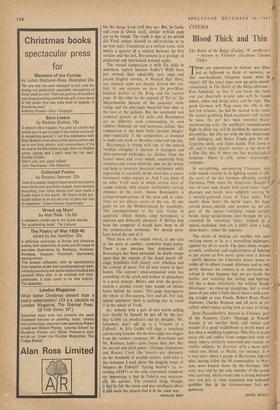MUSIC
What a Performance!
a() GOBBI'S costive production of Simon T Boccanegra, with himself in the lead, has been caned enough. No stripes shall be added by me. Some of my colleagues, however, have let condemnatory zeal spill over gratuitously from the visual and other aspects on to Verdi's score, which deserves nothing of the sort.
Two comparisons have been made that are intended to be damning. One is with Don Carlo. Like Boccanegra (1857), Carlo (1867) was re- vised by Verdi during the early 1880s with the help of that genius among librettists Arrigo Boito, author at later dates of the Otello and Falstaff books. It is generally accepted that the revisions added new depths to both works. In neither case was the process perfect, though.
The complaint could properly be made in the case of Boccanegra that the tremendous scene in the Doge's council chamber (the whole of it an 1881 interpolation) shows up the choral- orchestral high-jinks at the end of the Prologue for the cheap, brisk stuff they are. But, in Carlo, and even in Otello itself, similar stylistic gaps are to be found. The truth is that at no period did Verdi subject himself to self-criticism as to an iron yoke. Considered as a revised work, with nearly a quarter of a century between the first version and the last, Boccanegra is a prodigy of graduated and interlocked musical styles.
The second comparison is with Un ballo in inaschera, topical because Sadler's Wells have just revived their admirably cast, sung and played English version, A Masked Ball. Here, too, musical styles are sharply diverse but uni- fied. At one extreme we have the pre-Offen- bachian levities of the King and his traresti page. At the other lie the anguish of 'Ed tu.' the Meyerbeerian heroics of the assassins' oath- taking -and the piercingly beautiful love duet at the foot of the gallows. But the emotional 'and technical gamuts of Un hallo and Boccanegrp are so different, each commanding its own timbres, thematic cut and harmonic colour, that comparison is the most 'futile exercise imagin- able—especially if the comparison is intended to make one work or the other come out top dog.'
Boccanegra is strong with one of the central Verdian strengths; it abounds in dialogues and three-cornered exchanges (as distinct from the formal duets and trios) which, employing both recitative and arioso methods, spur on the action and help to generate theatrical excitement while engrossing us musically in the sense that a sonata movement might engross us. And I can think of no other Verdi score in which certain sorts of sound embody with greater inevitability certain elements in the story. Simon Boccanegra is corsair-turned-saviour of the state and its ruler. Thus we are always aware of the sea. At one point we see the Mediterranean by moonlight. The accompaniment to the aria 'Come in quest'ora' which Amelia sings hereabouts is aqueous and delicately plangent. If Berlioz had been the composer it would have been in all the orchestration textbooks. We should never have hoard the end of it.
Then there are the sounds which, at one turn of the story or another, symbolise dogal pomp. There is one instance that dominates all. Boccanegra has been poisoned. As death creeps upon him the captain of the dogal guard, off- stage, proclaims civil victory over rebellion and the coming of peace. Let all men return to their homes. The captain's unaccompanied voice has something of the pitch and pathos of plainchant in a great minster. Before and after the procla- mation a jocund, stately tune sounds on unison horns behind the scenes. This page impregnates the whole of Boccanegra, fore and aft. For sad, muted splendour there is nothing else to touch it in the whole of Verdi.
So: nobody with a pair of ears worth calling ears should let himself be put off by the fact that Gobbi (as producer) and his designer, Mr. Salimbeni, don't add up to a Visconti or a Zeffirelli. At fifty Gobbi still sings a trenchant and moving Simone. On the first night two singers from the resident company, Mr. Bryn-Jones and Mr. Rouleau, hadn't quite found their feet. But the second and third guests-L-Orianna Santunione and Renato Cioni (the lovers)—are obviously on the threshold of notable careers. And what is this nonsense I read about the sluggish tempi of Maestro de Fabritii? Taking Santini's 1.p. re- cording (HMV) as the only convenient standard, my impression is that de Fabritii was occasion- ally the quicker. The essential thing, though, is that he felt the music and was intelligent about it and made his players feel it in the same way.
CHARLES REID







































 Previous page
Previous page